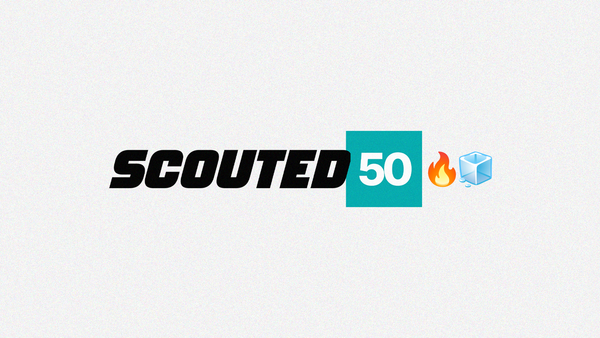An introduction to Full-Back Archetypes
How to discover the next generation of three diverging full-back profiles

Editor's note: as we're in the midst of an international break, Jake's taking a quick break from Monday Night SCOUTED. That'll return next week; in its place, here's the latest instalment in our long-term Archetypes project, powered by SkillCorner data.
Full-back has become the most varied position on the pitch. By focussing on SkillCorner’s Physical and Game Intelligence metrics, three distinct Archetypes begin to materialise.
For more on SCOUTED Archetypes, check out our introduction to the first: Power Forwards.
Even within a single team, the role of one Full-Back may contrast their team-mate’s on the opposite flank. Take Trent Alexander-Arnold and his wingman Andrew Robertson. They are the most prolific assist-providing full-backs in Premier League history, but climbed the ranking in their own unique way. Alexander-Arnold will be remembered as one of the competition’s greatest passers, a Pathfinder. Meanwhile, the limitless engine of Robertson turned him into a full-metal Flyer.
Fabian Delph was arguably the Full-Back Imposter in the modern era of the English top-flight, a league now littered with midfielders inverting from this role. A box-to-box CM by trade, Delph started 21 Premier League games at left-back during the Centurions campaign of 2017/18, including 14 of their record-breaking 18-match winning streak.
This analytical piece is an introduction to the first three Full-Back SCOUTED Archetypes: the Flyer, the Pathfinder and the Imposter. By interrogating Physical, Off-Ball Running, Passing and Overcoming Pressure data, each Archetype emerges with a different SkillCorner metric group at its core. This article will uncover the superpower that helps accelerate the discovery of each profile and explore how to evaluate the talent unearthed.
The Flyer
The first Full-Back Archetype will be the most familiar. The Flyer is characterised by the lung-busting runs and the relentless whipping of crosses synonymous with the traditional role. Physical metrics are at the core of this profile - in that sense, this could be seen as the Full-Back equivalent of the Power Forward. As we found with that centre-forward profile, specific Off-Ball Running and Passing metrics appear to be augmented by certain Physical markers.
This Milos Kerkez run against Newcastle is the personification of the Flyer Archetype - it is even more impressive when you consider it happened in the sixth minute of second-half injury time. That weekend, Kerkez recorded the quickest Time to High Speed Run of any Full-Back in the Premier League (0.54) and recorded the second-most Sprints In Possession, behind Antonee Robinson. Immediately, Explosiveness, High Speed and Sprinting jump out as core metrics.
The High Speed Running (20-25 km/h) and Sprint (>25 km/h) speed bands combine to create SkillCorner’s High Intensity metric, measuring any action above the 20 km/h threshold. If we plot our Full-Back dataset using High Intensity Actions P30 TIP and Peak Sprint Velocity-99, it immediately captures both Kerkez and Robinson, perhaps the greatest exponents of the Flyer Archetype in the Premier League right now. Adjusting the size of each datapoint to the Percentage of High Intensity Actions as Sprints helped pinpoint the rocket-booted Flyers - Robinson topped this particular metric, Kerkez ranked third.
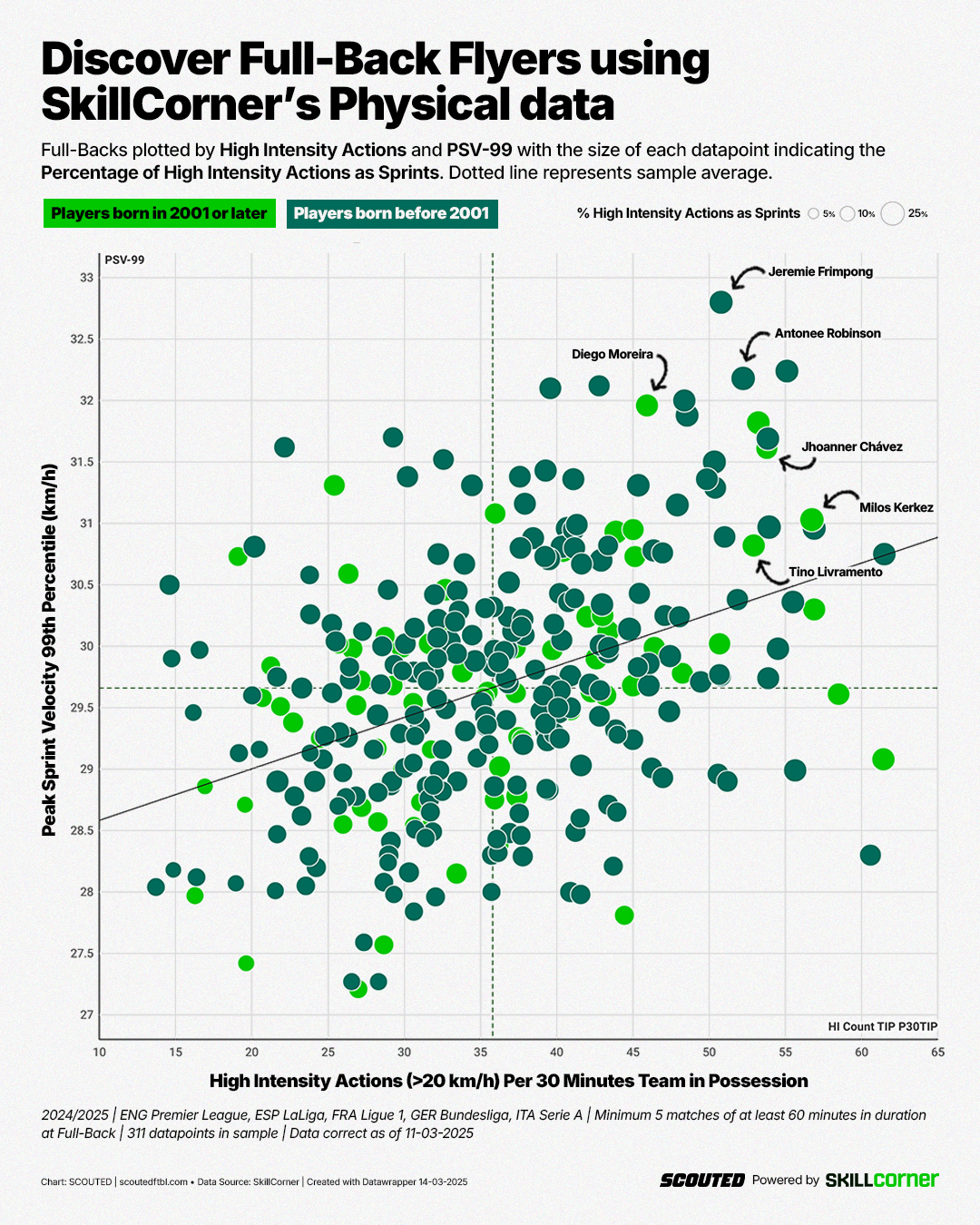
Now, let’s explore the Off-Ball Running profile of these Flyers to discover the results of this explosive speed.
The previous SkillCorner research I highlighted for Introduction to the Power Forward tells us the most common Run types for Full-Backs are Runs Ahead of the Ball, Support Runs and Overlap Runs. To help distinguish the uniqueness of each Archetype and provide a way to evaluate the byproduct of the Physical output, it helps to look at these 10 Run Types as Run Groups.
Build-Up Runs
Essentially, any run in which the recipient is asking for the ball to feet.
- Dropping Off: a run towards the team in possession’s goal to open a passing angle
- Coming Short: a run towards the player in possession to receive a short pass
- Pulling Wide: a run starting in the centre of half-space channel and ending in the wide channel with the location wider than the player in possession
- Pulling Half Space: a run occurring in the attacking third that starts in the centre channel and ends in the half space channel
Progression Runs
Within this group, there is an important sub-group for the Flyer Archetype in particular.
- Support Runs: a run originating behind the player in possession trying to engage in offensive play
- Overlap: a run in the wide or half-space channels, originating behind the player in possession and ending ahead and outside of the player in possession - combine with Underlap to create Lapping Runs
- Underlap: a run in the wide or half-space channels, originating behind the player in possession and ending ahead and inside of the player in possession - combine with Overlap to create Lapping Runs
- Runs Ahead of the Ball: a run originating ahead of the player in possession, running towards the opponents’ goal but not going beyond the last defensive line
Direct Runs
These runs are typically closest in proximity to the opposition box.
- Runs In Behind: a run into space behind the opponents’ last defensive line
- Cross Receiver Runs: a run towards the penalty area to receive a possible cross
Although Support Runs and Runs Ahead of the Ball - the two most frequent Run types for Full-Backs - belong to the Progression Run Group, considering them independently enables us to hone in on stylistic differences due to their diverging origin points. For Full-Backs, and the Flyer Archetype in particular, it is important to combine Overlaps and Underlaps into Lapping Runs and to separate this sub-group from the Progression umbrella. As you will see, each Archetype becomes synonymous with an entire Run Group or, at the very least, a particular Run type within that group.
The Flyer will make more Runs Ahead of the Ball than Support Runs due to their proclivity for flying forward. However, the volume of Lapping Runs is what separates this Archetype stylistically from the others. Kerkez, for example, has the highest Percentage of Runs P30 TIP as Lapping Runs (30.3%) in the entire dataset. As you will see on the graphic below, he has a relatively even split between Underlaps and Overlaps, highlighting the value of combining them in the early discovery phase.
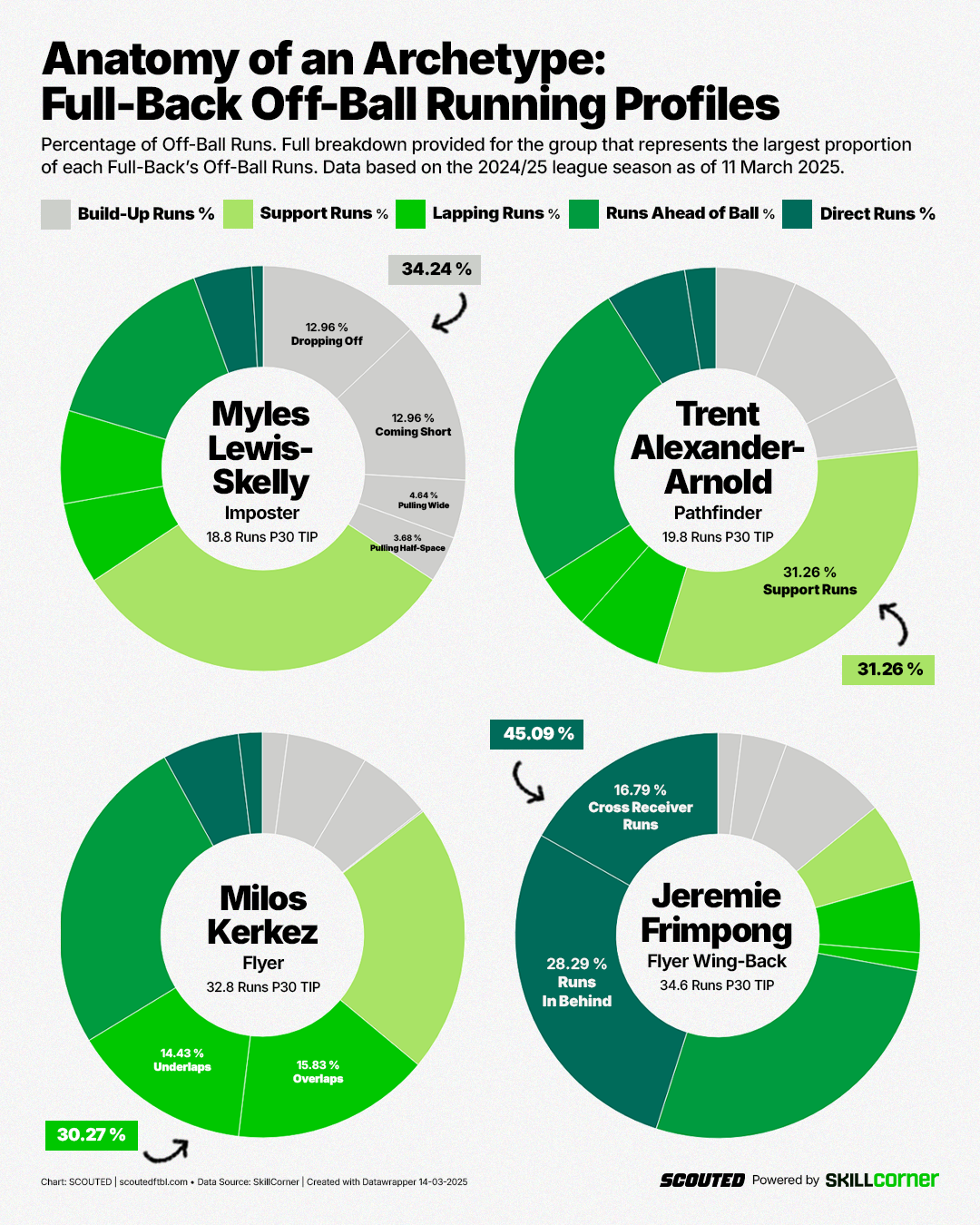
There was strong correlation between High Intensity Actions and Lapping Runs (0.61 correlation coefficient) as well as the Threat of Lapping Runs (0.57). This suggests a symbiotic relationship between specific Physical and Off-Ball Running metrics and helps illustrate the exact profile we are trying to build. The following scatter once again displays High Intensity Actions P30 TIP; this time, it is plotted alongside Lapping Runs while the Threat generated from these Lapping Runs dictates the size of the datapoint. Milos Kerkez is the clear Poster Boy.
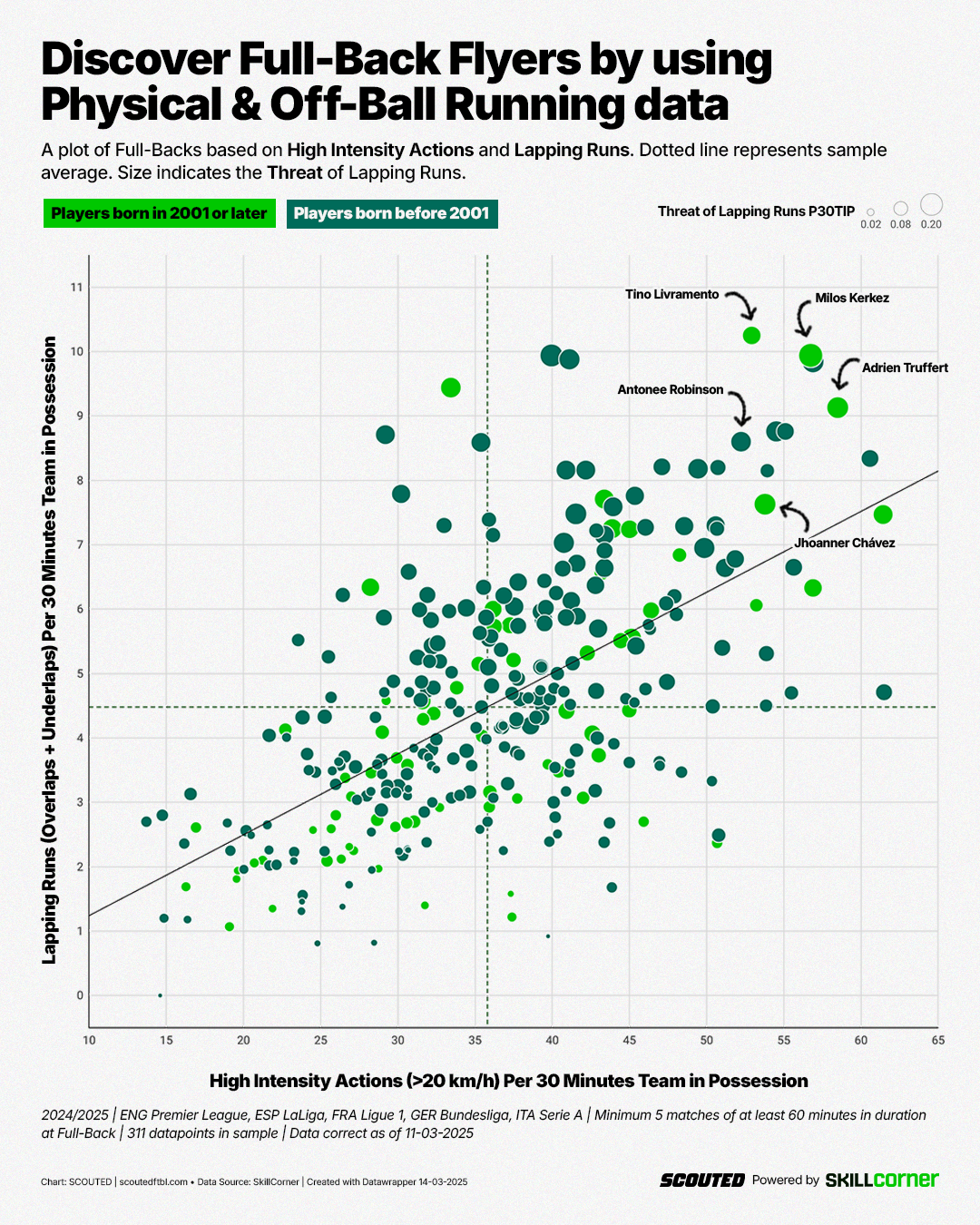
In order to distinguish between Flyer Full-Backs and Wing-Backs, we have to make a simple adjustment to the discovery process: swap Lapping Runs to Direct Runs, a combination of Runs In Behind and Cross Receiver Runs. A wild Jeremie Frimpong appears.
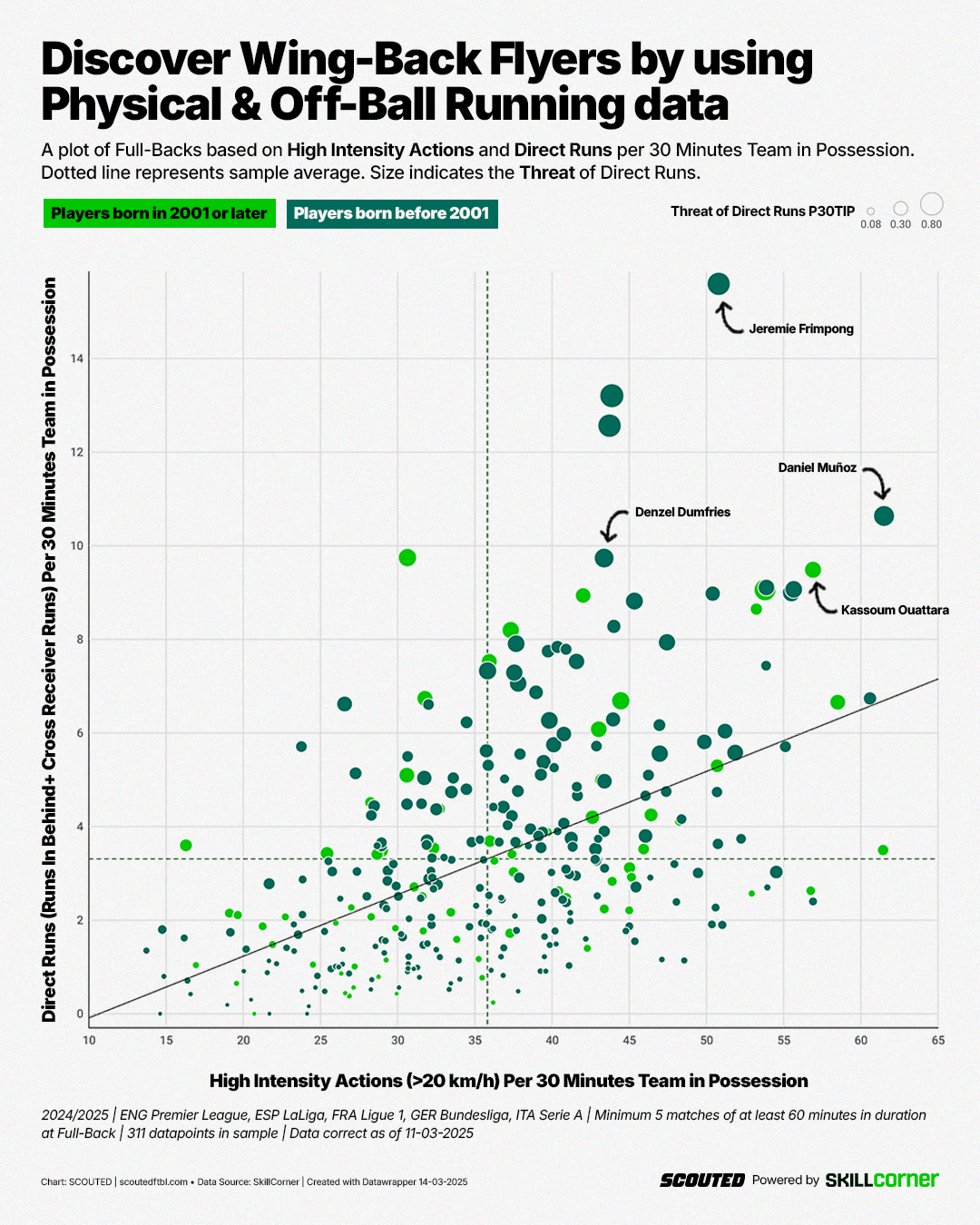
It seems, then, that by searching for Full-Backs that make more High Intensity, Explosive Runs when their team is in possession, the more likely we are to discover Full-Backs that generate more Threat with Lapping Runs or Raiding Runs. Of course, this will not always be the case, but it provides a clear framework to build on. For example, of the 10 players that rank in the top 10% for High Intensity Actions P30 TIP, Explosive Accelerations to High Intensity P30 TIP and PSV-99, nine of them rank in the top 10% for Lapping Runs or Direct Runs - Ali Abdi, the only player that does not, ranks in the top 15% for both. The only player that ranks in the top 10% in terms of volume and Threat for both types of Run is left-back Jhoanner Chávez, a 2002-born Independiente del Valle academy graduate on loan at RC Lens from Brazilian side Bahia.
The Anatomy of a Flyer Full-Back
When compared to the average Full-Back, the following is likely to apply to the Flyer when normalising stats based on the Per 30 Minutes Team in Possession filter:
- Physical: more High Intensity Activity and more High Intensity Distance covered; Sprints will make up a larger proportion of Running Distance and High Intensity Actions; quicker PSV-99, Time To HSR and Time To Sprint speeds; more Explosive Accelerations.
- Off-Ball Running: more Lapping Runs - swap Lapping to Direct when applying to Wing-Backs - and a larger proportion of their Off-Ball Runs will be Lapping Runs; generate more Threat via Lapping Runs and a greater proportion of total Threat generated will be via Lapping Runs
- Passing: more Opportunities to Pass to Cross Receiver Runs and a greater percentage of Pass Attempts to Runs will be Pass Attempts to Cross Receiver Runs; large proportion of Threat generated via Pass Attempts to Runs will be Threat from Pass Attempts to Cross Receiver Runs
In the main, the product of these Explosive, High Intensity Lapping Runs will be Opportunities to Pass to Cross Receiver Runs. However, we should explore the process of evaluating a Full-Back’s ability to spot and execute specific passes through the lens of the Full-Back Archetype with Passing as the core metric group. Introducing…
The Pathfinder
Previous research by SkillCorner discovered that Full-Backs are presented with more Passing Opportunities than any other Position Group. Runs Ahead of the Ball are the most common option available, followed by Coming Short Runs, Runs In Behind and Cross Receiver. Due to the relationship between High Intensity Actions and Lapping Runs, the Flyer Archetype becomes synonymous with Cross Receiver Runs. Meanwhile, as you may have predicted, Build-Up Runs will be associated with the Imposter. That leaves Runs Ahead of the Ball and Runs in Behind for our premium passing Archetype.
To show the value of focussing specifically on these groups, let's take a look at Trent Alexander-Arnold. When looking at his Passes to All Runs, he ranks in the 59th Percentile for Attempts. However, when focusing on Runs In Behind and Runs Ahead of the Ball, he becomes a top 5% player.
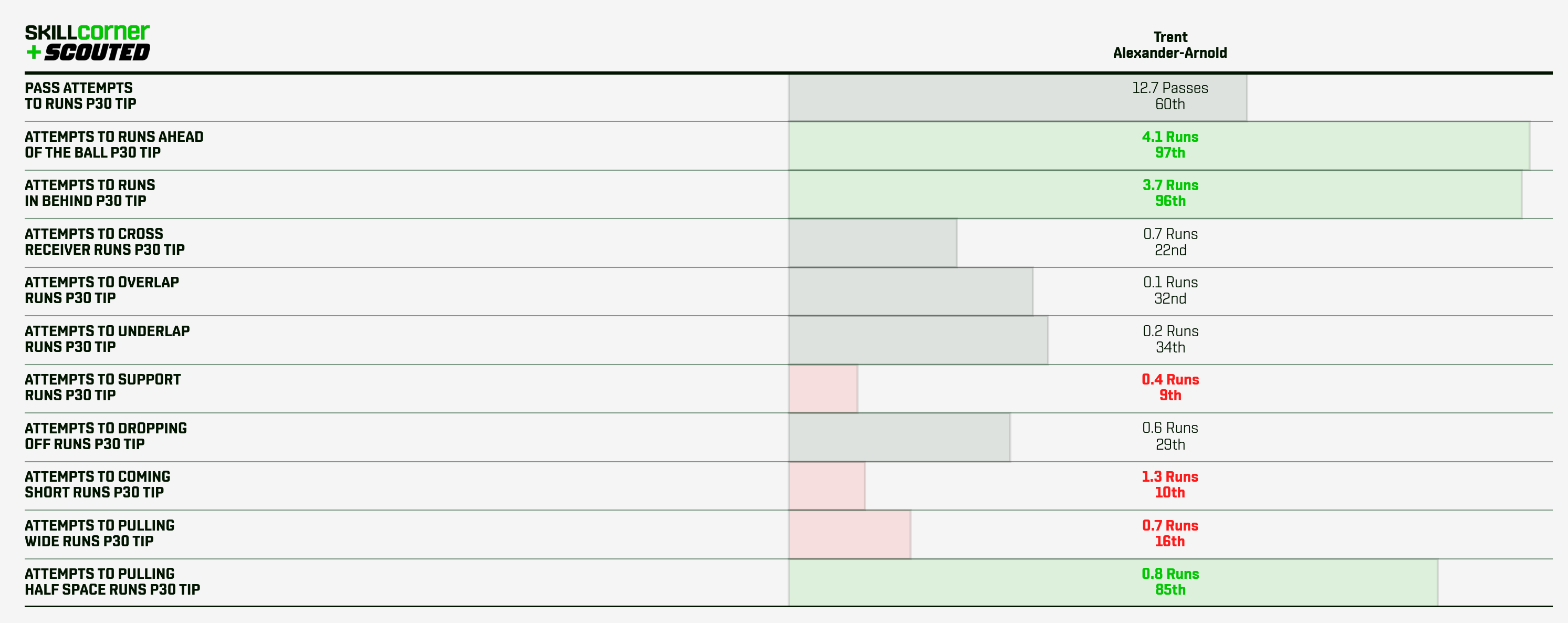
Of course, his increased Opportunities to Pass to these Runs is likely influenced by Liverpool’s style, but it highlights the concentration of his Passing profile. 61.4% of his Pass Attempts P30 TIP are what we will refer to from now on as Pathfinder Passes, a combination of Passes to Runs Ahead of Ball and Passes to Runs In Behind - this is the highest concentration of Pathfinder Pass Attempts in our dataset. So, to discover stylistic matches, we can plot the volume of Pathfinder Passes with the Percentage of Passes to Runs that are Pathfinder Passes. However, due to Pass Attempts to Runs Ahead of the Ball or Support Runs making up a decent chunk of all Full-Back Passing profiles, adjusting the size of each datapoint to the Percentage of Pass Attempts to Runs In Behind helps uncover the more direct, expansive Pathfinders, like Alexander-Arnold - 29.6% of his Pass Attempts to Runs are Pass Attempts to Runs in Behind.
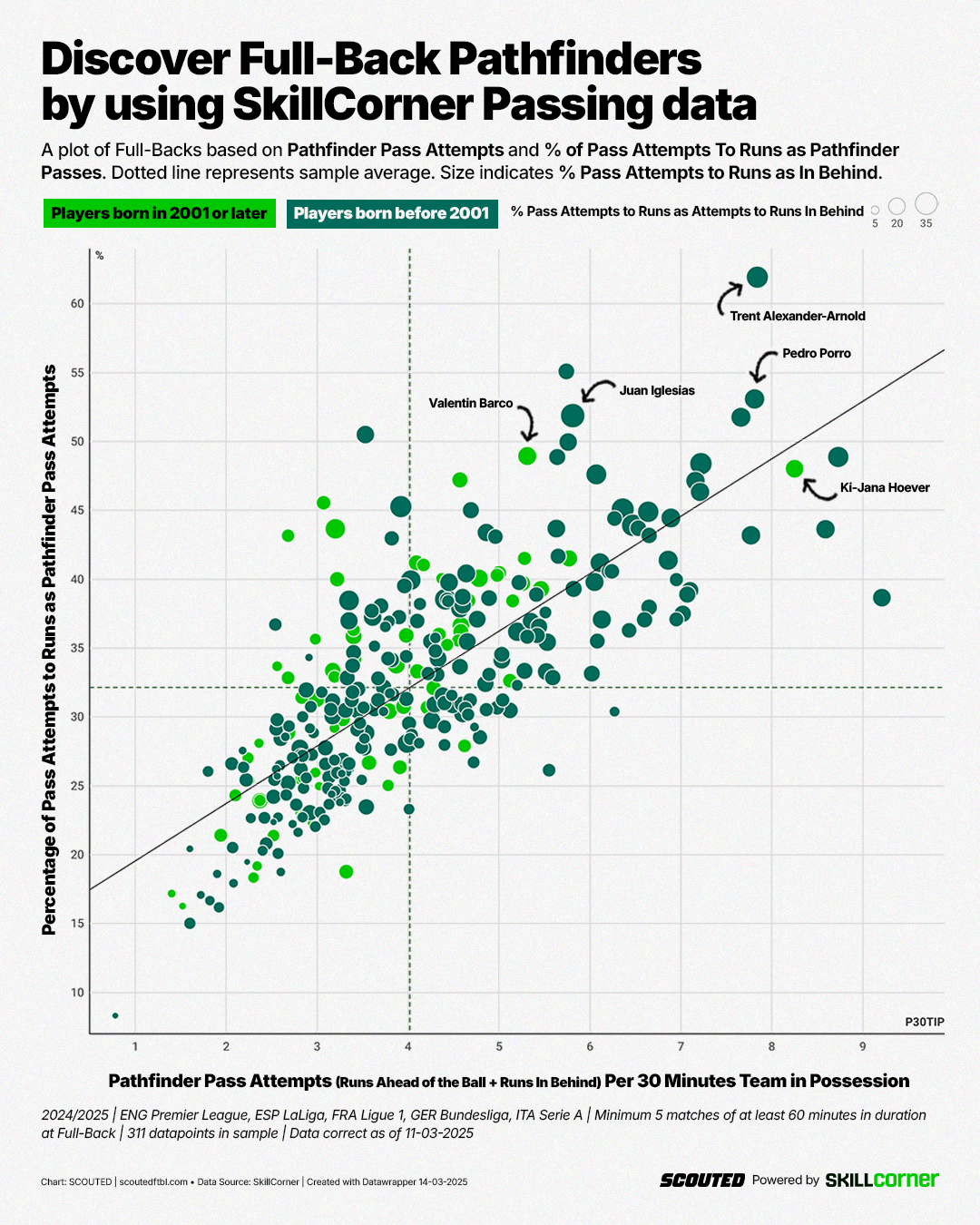
The next stage of the Pathfinder discovery phase is to combine these Passing metrics with the Overcoming Pressure Game Intelligence suite.
The Anatomy of a Pathfinder Full-Back
When compared to the average Full-Back, the following is likely to apply to the Pathfinder when normalising stats based on the Per 30 Minutes Team in Possession filter:
- Passing: more Pass Attempts to Runs Ahead of the Ball and Runs In Behind (Pathfinder Passes) with a greater Percentage of Pass Attempts to Runs as Pathfinder Passes - the greater the proportion of Pass Attempts to Runs In Behind, the more expansive the Pathfinder
- Passing: more Pass Attempts to Dangerous Runs Ahead of the Ball and Dangerous Runs In Behind (Dangerous Pathfinder Passes) and greater proportion of Threat generated via Pass Attempts to Runs Ahead of the Ball and Pass Attempts to Runs In Behind
- Overcoming Pressure: more Difficult Pass Attempts Under Pressure
The Pathfinder Archetype is the high-risk, high-reward passer. So, in order to identify Full-Backs that are relentless and fearless in their attempts to seek out advanced teammates running into space, we can look at Dangerous Pathfinder Pass Attempts alongside Difficult Pass Attempts under Pressure. Ironically, it appears that a previous Trent Alexander-Arnold understudy, Ki-Jana Hoever, could be a Pathfinder protégé. The former Liverpool full-back is currently on loan at Auxerre from Wolves.

You would be able to refine this dataset further by focussing specifically on Pass Attempts to Runs In Behind or even Difficult Pathfinder Passes under Pressure. You could then look at passing habits under Low, Medium and High Pressure and which thirds or channels of the pitch each Full-Back operates in. But to really emphasise the value of those adjustments, we will move on to the third Full-Back Archetype which centres on Overcoming Pressure. Meet…
The Imposter
The most important thing to remember when beginning this search is that any player can fulfil this role. In fact, the Imposter has quickly become a proxy for academy graduates or inexperienced players to gain senior minutes, especially midfielders - you could argue the likes of Rico Lewis, Jack Hinshelwood and Myles Lewis-Skelly are all at different stages of their Fabian Delph arc. This is because they are usually tasked with playing as a midfielder in Full-Back pyjamas. Above all else, the Imposter Full-Backs retain possession. Whether that be through press resistance or inverting to assist with the build-up, they are the yin to the Pathfinder’s yang.
So, rather than focussing on the Danger and Difficulty of Passes as we did for the Pathfinder, we will now focus on the Full-Backs’ ability to secure possession under varying degrees of pressure. The aforementioned Lewis-Skelly ranks highest for Retention Rate and third for Retention Rate under High Pressure. The fact he is the safest passer - i.e. he has the lowest Percentage of Passes under Pressure that are Difficult - plays a part. But that is the role he is asked to fulfil.
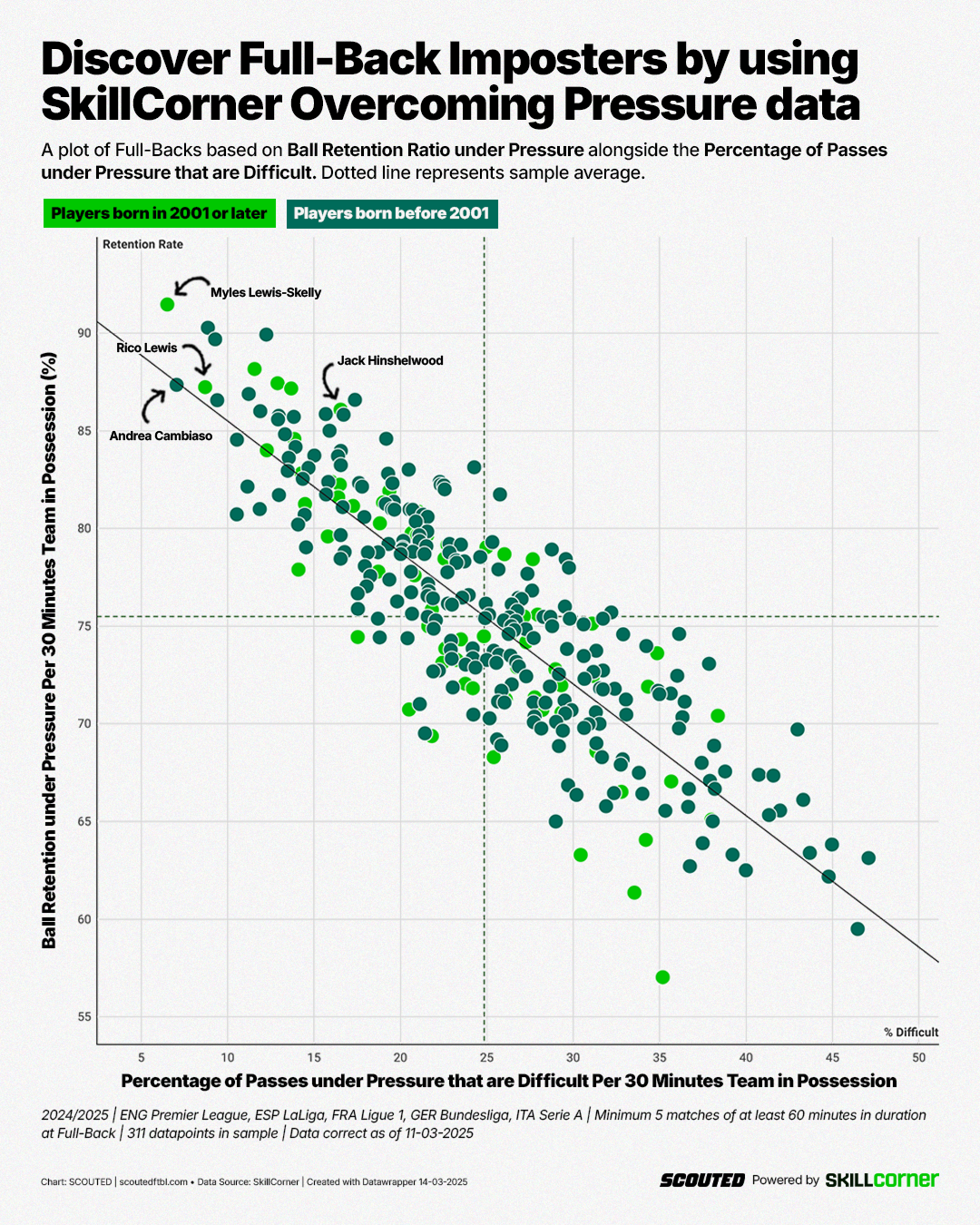
To discover and evaluate the most cunning Imposters, we can focus specifically on the Half-Space, inclusive of the left and the right. By plotting Percentage of High Pressures Received in these channels alongside High Pressure Retention Rate in the Half-Space we can not only spot players that have made a natural habitat in these midfield waters but also snap assess which Full-Backs sink and which Full-Backs swim when wading into them.
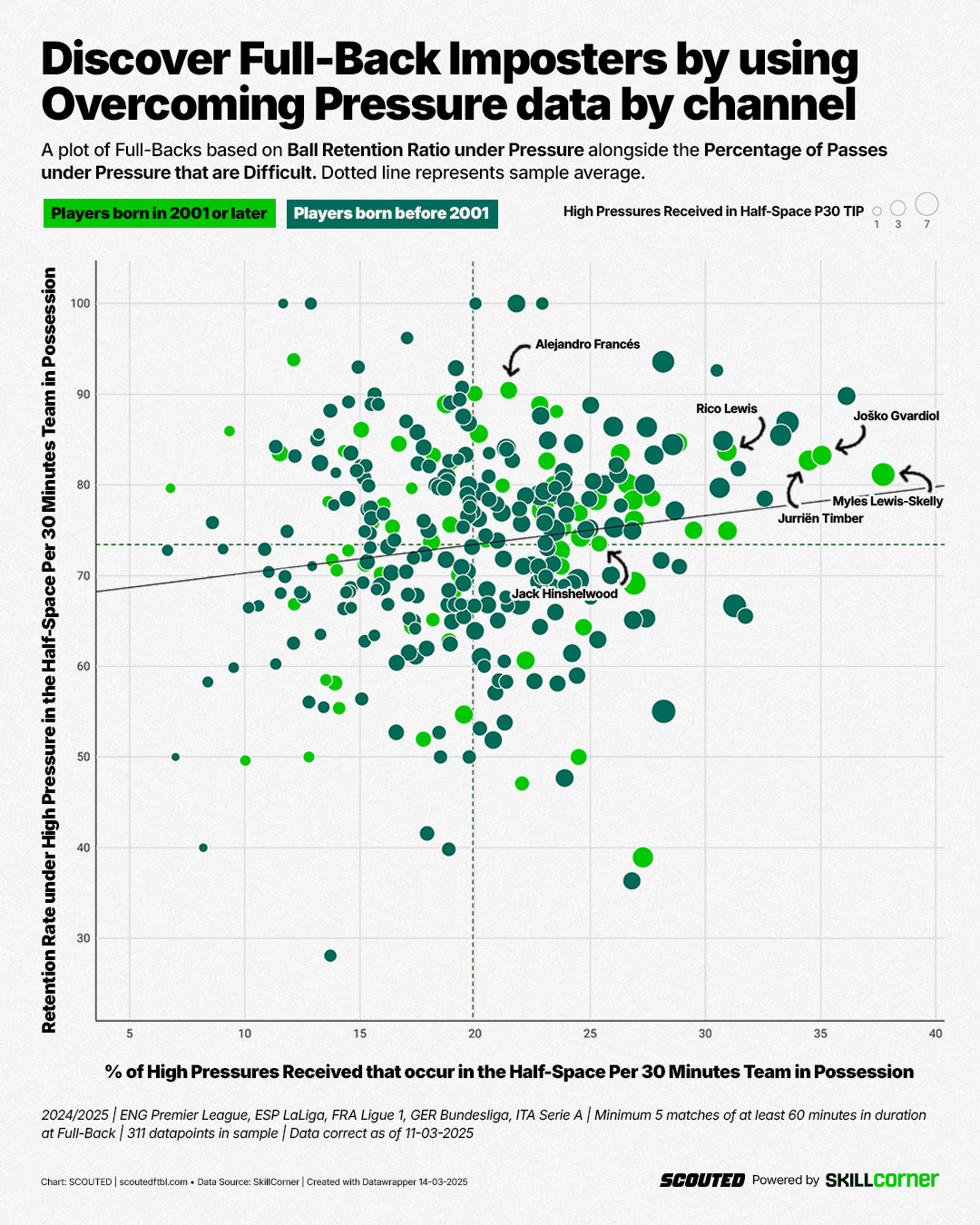
Through this Half-Space lens, team style stands out: two Arsenal Full-Backs and Manchester City’s Joško Gvardiol are clustered together, while Rico Lewis is nearby.
The Anatomy of an Imposter Full-Back
When compared to the average Full-Back, the following is likely to apply to the Imposter when normalising stats based on the Per 30 Minutes Team in Possession filter:
- Overcoming Pressure: higher Retention Rate across all areas of the pitch and all three degrees of Pressure; lower proportion of Pass Attempts Under Pressure that are Difficult
- Overcoming Pressure: higher percentage of Pressures Received occur in the Half-Space and higher Retention Rate in these channels; higher percentage of Pass Attempts Under Pressure will occur in the Half-Space
- Off-Ball Running: makes fewer Off-Ball Runs overall but a higher proportion of Off-Ball Runs will be Build-Up Runs
The secondary group for the Imposter Archetype is Off-Ball Running, focussing specifically on Build-Up Runs. Here is another reminder of that group:
• Coming Short: a run towards the player in possession to receive a short pass
• Pulling Wide: a run starting in the centre of half-space channel and ending in the wide channel with the location wider than the player in possession
• Pulling Half Space: a run occurring in the attacking third that starts in the centre channel and ends in the half space channel
Plotting the Percentage of Runs as Build-Up Runs alongside the Percentage of Pass Attempts Under Pressure in the Half-Space helps differentiate the style of players operating in the Imposter Role. In this data visualisation, Lewis-Skelly, Gvardiol and Timber diverge.
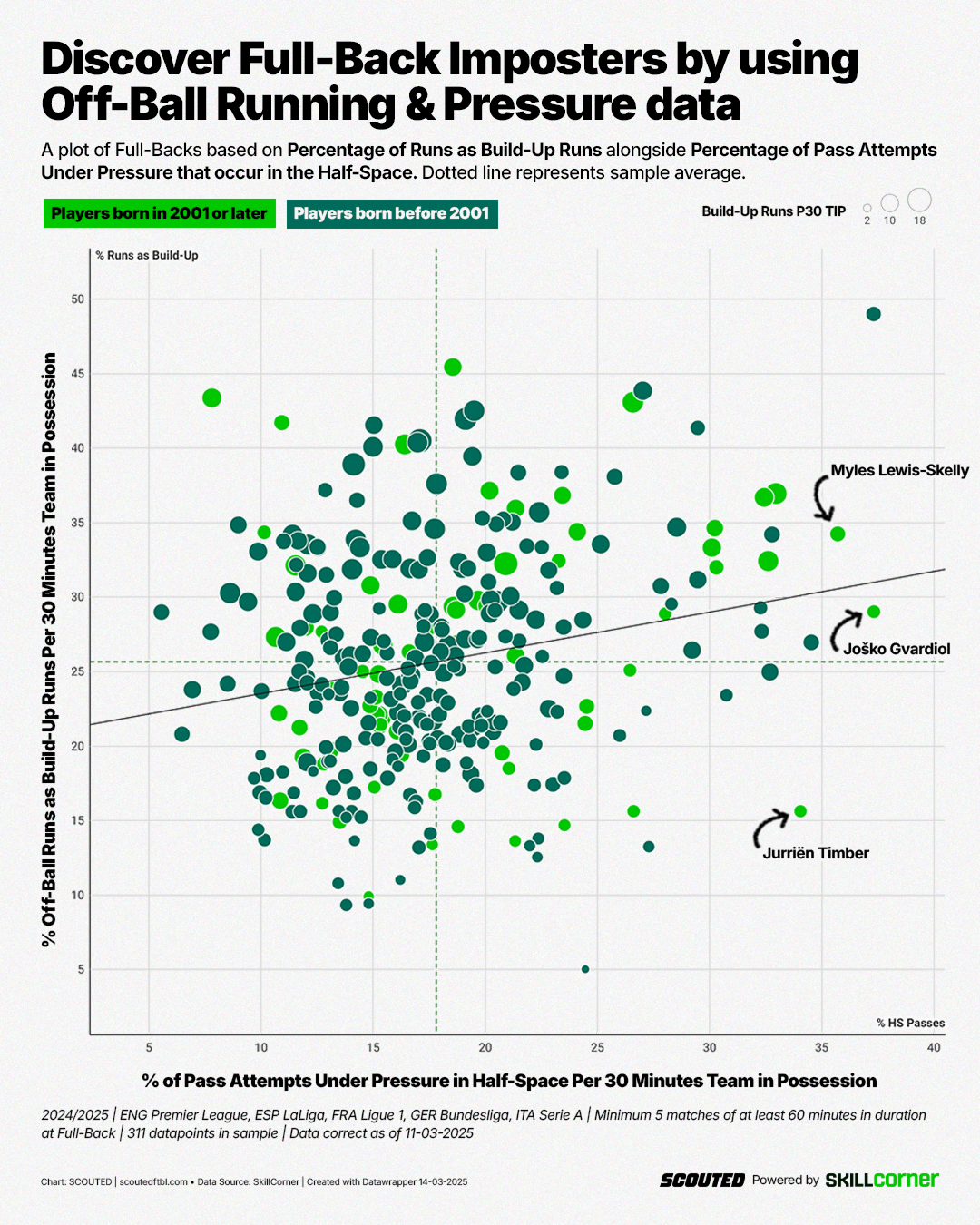
For an even more granular search, you could split these Imposters into sub-classes by looking at Support Runs versus Runs Ahead of the Ball. To double down on the first-phase Build-Up Imposters, look at Support Runs. To find Imposters roaming into the pockets in the final third, focus on Runs Ahead of the Ball.
There is even an argument to be made that Imposter and Invader could exist as two separate Archetypes. But…
This is just the start
With so many mainstream names highlighted, I would not forgive you for thinking that all of this seems obvious. However, the aim of these Archetypes is not to show you that Milos Kerkez loves an Overlap (and an Underlap), that Trent Alexander-Arnold is a pass master, or that Myles Lewis-Skelly rarely loses the ball. You already know that. The magic is you can apply all of the same tests to a league, a region or even an entire continent no-one else is looking at to discover players in the profiles you want.
This is just the beginning for these three Full-Back Archetypes. The ability to refine each In-Possession Archetype further through pitch zones and channels already exists. But the potential to combine each profile with an Out-of-Possession style will be unlocked by the release of SkillCorner’s OOP data. With that, you can discover an Imposter that Padlocks opposition wingers or a Flyer that doubles as a Super Sweeper. What are you waiting for?





